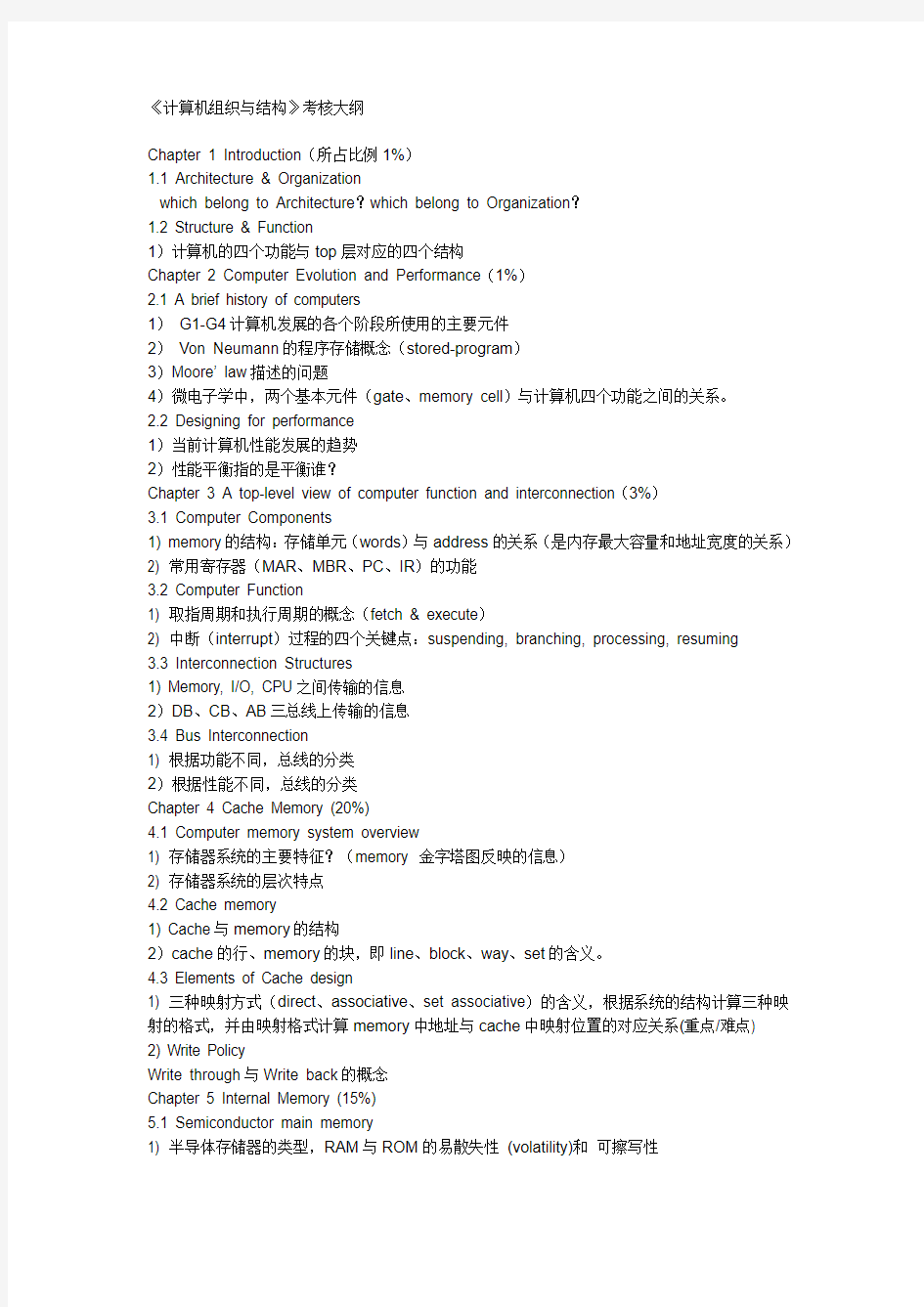coa考试大纲


《计算机组织与结构》考核大纲
Chapter 1 Introduction(所占比例1%)
1.1 Architecture & Organization
which belong to Architecture?which belong to Organization?
1.2 Structure & Function
1)计算机的四个功能与top层对应的四个结构
Chapter 2 Computer Evolution and Performance(1%)
2.1 A brief history of computers
1)G1-G4计算机发展的各个阶段所使用的主要元件
2)Von Neumann的程序存储概念(stored-program)
3)Moore’ law描述的问题
4)微电子学中,两个基本元件(gate、memory cell)与计算机四个功能之间的关系。
2.2 Designing for performance
1)当前计算机性能发展的趋势
2)性能平衡指的是平衡谁?
Chapter 3 A top-level view of computer function and interconnection(3%)
3.1 Computer Components
1) memory的结构:存储单元(words)与address的关系(是内存最大容量和地址宽度的关系)
2) 常用寄存器(MAR、MBR、PC、IR)的功能
3.2 Computer Function
1) 取指周期和执行周期的概念(fetch & execute)
2) 中断(interrupt)过程的四个关键点:suspending, branching, processing, resuming
3.3 Interconnection Structures
1) Memory, I/O, CPU之间传输的信息
2)DB、CB、AB三总线上传输的信息
3.4 Bus Interconnection
1) 根据功能不同,总线的分类
2)根据性能不同,总线的分类
Chapter 4 Cache Memory (20%)
4.1 Computer memory system overview
1) 存储器系统的主要特征?(memory 金字塔图反映的信息)
2) 存储器系统的层次特点
4.2 Cache memory
1) Cache与memory的结构
2)cache的行、memory的块,即line、block、way、set的含义。
4.3 Elements of Cache design
1) 三种映射方式(direct、associative、set associative)的含义,根据系统的结构计算三种映射的格式,并由映射格式计算memory中地址与cache中映射位置的对应关系(重点/难点)
2) Write Policy
Write through与Write back的概念
Chapter 5 Internal Memory (15%)
5.1 Semiconductor main memory
1) 半导体存储器的类型,RAM与ROM的易散失性(volatility)和可擦写性
5.2 Error Correction(重点/难点)
1) 海明码纠错的原理
2) 海明码纠错的计算过程
Chapter 6 External Memory(5%)
6.1 Magnetic disk
1) 磁盘的特点
2) 磁盘性能参数:寻道时间(seek time)、旋转延迟(rotational delay)的概念
6.2 RAID (难点)
1) RAID的特点
2) parallel access(并行存取)和independent access(独立存取)的区别,各自适用的等级6.3 Optical memory
1)光盘的分类
Chapter 7 Input/output(5%)
7.3 Programmed I/O
1)可编程I/O的缺点
7.4 Interrupt I/O
1)中断的处理过程(重点/难点)
7.5 DMA
1)DMA的工作过程(重点/难点)
Chapter 9 Computer Arithmetic(3%)
9.1 The Arithmetic and Logic Unit
1)ALU的功能,输入和输出
9.2 Integer Representation
1)符号-有效值(sign-magnitude)和补码(Twos complement)的表示范围
2)n-bit与m-bit的数据扩展原则
9.3 Integer Arithmetic
1)求负运算的计算方法
2)加减法中判断溢出的方法和补码的加减运算
Chapter 10 Instruction sets:Characteristics and function(3%)
10.1 Machine Instruction Characteristics
1)指令中的基本要素
2)源操作数和结果存放的位置
3)指令中地址的数量与表示的含义
10.4 Types of operations
1)常用的转移指令的含义:BR,ISZ,CALL ,Return
Chapter 11 Addressing mode and formats(15%)
11.1 Addressing(重点/难点)
1. 常用七种寻址方式的优缺点
2. 七种寻址方式的示意图表示
3. 偏移寻址的三种不同类型
Chapter 12 CPU Structure and Function(3%)
12.2 Register Organization
1)用户可见寄存器(user visible)和控制状态寄存器的含义
12.3 Instruction cycle
1)间址周期的概念
2)指令周期的正确顺序
3)取指周期和间址周期的数据流表示
12.4 Instruction Pipelining
1)影响流水线技术的最坏因素
Chapter 16 Control Unit Operation(16%)
16.1 Micro-operations(重点/难点)
1)微操作的概念
2.)常用汇编指令到微操作的设计(符号表示)
16.2 Control of the Processor
1)控制器的输入输出
Chapter 18 Parallel Organization(10%)
18.1 Multiple Processor Organization
1)并行处理的分类
18.2 Symmetric Multiprocessors
1)分时共享总线的机结构特点
2)紧耦合和松耦合的结构
18.3 Cache Coherence and the MESI Protocol(重点/难点)
1)MESI协议4种状态的含义
2)MESI协议中四种情况(read/write hit on/miss)描述,状态转换图的画法
其他说明情况:
客观题主要是选择题及部分判断题,总分在35~40分之间;主观题在下列5个重点内容中出题,一般出大题,总分在60~65分。这些章节中除了出大题以外,还应该适当出部分小题。
4.3 Elements of Cache design(重点/难点)(14~16分)
1) 三种映射方式(direct、associative、set associative)的含义,根据系统的结构计算三种映射的格式,并由映射格式计算memory中地址与cache中映射位置的对应关系
5.2 Error Correction(重点/难点)(13~15分)
1) 海明码纠错的原理
2) 海明码纠错的计算过程
11.1 Addressing(重点/难点)(12分)
1. 常用七种寻址方式的优缺点
2. 七种寻址方式的示意图表示
3. 偏移寻址的三种不同类型
16.1 Micro-operations(重点/难点)(13~14分)
Chapter 18 Parallel Organization(15%)
18.3 Cache Coherence and the MESI Protocol(重点/难点)(8分)
1)MESI协议4种状态的含义
2)MESI协议中四种情况(read/write hit on/miss)描述,状态转换图的画法
